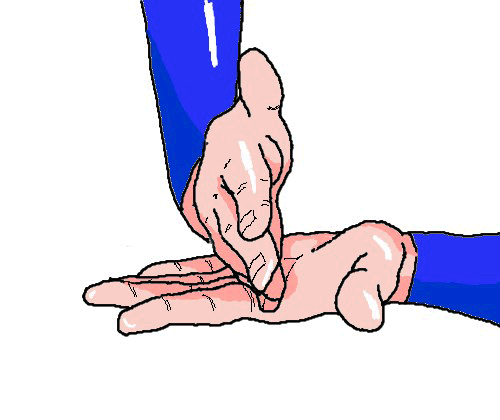Now you have decided on your spot card and honor sequence leads. And you have decided your own priorities for signals to partner’s opening lead (read Part 1 of this Guide if you haven’t). In Part 2 we looked at a few examples of other signals available to you at trick one. Part 3 deals with a few cases when the 3rd hand’s spot card is not your agreed preference (attitude, count or suit preference). Part 4 explains the most common attitude, count and suit preference signals.. In Part 5 you have put together your partnership signaling agreements.
Now that you have your agreements firmly in place, it is time to see how these signals can be help to you. Here is one that my partner faced on BBO:
Your partner disappoints you by leading the ♠Q right into dummy’s AKJ-fifth suit… the Ace wins. Now is the time to think about the distribution, and what cards partner has from the bidding and from his “signals”.
Partner will not be getting in too many times, so giving him count or attitude is not so critical. You might decide to play a low ♠ no matter what your carding is.
Dummy then plays the ♦2, You jump up with the ♦K, LHO plays the 5 and partner the 3 if playing UDCA and the T if playing standard.
Time to really think, as a lotof IMPs are on the line here.
- Why did partner, who couldn’t keep the bidding open over 1♥ dbl 1NT?
- How many spades can we infer partner has?
- What was the diamond signal?
These are all logical.
- Partner’s dbl was an attempt to get you to bid a minor, he must have both minors… you knew this when you doubled 3NT.
- Partner will not have three hearts or when he decided to compete to the 2nd level he would have bid 2♥ rather than try to get you to bid a minor.
- The diamond signal shows a four card suit. By inference, he must have a four or more likely five card club suit (given he didn’t just bid 2♣ over 1NT with six).
- West is unlikely to have 3 Spades and never support East, and with three Spades partner would not have lead the unsupported ♠Q.
So because of the Diamond signal, the distributions are double dummy. Partner is 2-2-4-5 and declarer is 2-4-2-5… all this from the combination of
b) a clue from the opening lead, and
c) one count signal in Diamonds.
Armed with this information, plan your defense… A whole lot of IMPs are at stake!
After counting distribution, your next task, which is much easier, is to count tricks.
- Does partner have Heart A or K?
No, with heart honor and spade Queen, he would have bid.
So give 2 heart tricks to West. - You can see 3 Spade tricks and 4 Diamond tricks, AQJ (partner could afford to signal with the Ten; if he had the Jack, he would have played the Jack) and the long diamond.
That is 9 tricks for the taking for declarer… except…. ta da… your partner’s SPADE lead now looks brilliant. - A spade back by you cuts their transportation. Instead of 4 diamond tricks declarer can only enjoy two. That drops him from 9 to 7 tricks.
- He can establish a long spade by giving one to you, but that will still be one trick too little if partner holds something for his Double in the form of the Club Queen for example.
- Surely with ♠Qx and ♦Txxx, he must hold a club honor.
So a spade return will beat the contract. The full hands are:
center>
Now I will not say that this was an easy defense to find at the table, but clearly without counting the hand, the defense has no chance to go right here. Notice also that one signal in one suit by partner (in Diamonds) can help you determine the entire hand and play it double dummy at trick two. Using the signal and beating 3NTXX one is worth 400 points, while letting them make is -1000 points. The IMP swing would be win 11 imps for beating it one, lose 14 imps for allowing it to make.
To be continued…
Esta entrada también está disponible en: Spanish

